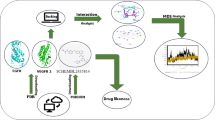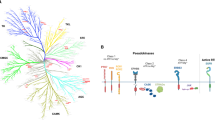Abstract
Aberrant activation of ERK signaling pathway usually leads to oncogenesis, and small molecular agents targeting this pathway are impeded by the emergence of drug resistance due to reactivation of ERK signaling. Compound DEL-22379 has been reported to inhibit ERK dimerization which was unaffected by drug-resistant mechanism reactivating the ERK signaling. Here, we discussed a structure–activity relationship study of DEL-22379. Forty-seven analogues were designed and synthesized. Each synthesized compound was biologically evaluated for their inhibitory rates on several tumor cell lines and compounds with high inhibitory rates were further evaluated for IC50 values. The structure–activity relationship of idolin-2-one scaffold and the impact of Z/E configuration on potency were discussed. Potential safety of two synthesized analogues was investigated and in silico docking study of five compounds was performed to understand the structural basis of ERK dimerization inhibition.
Graphic abstract















Similar content being viewed by others
References
Arozarena I, Calvo F, Crespo P (2011) Ras, an actor on many stages: posttranslational modifications, localization, and site-specified events. Genes Cancer 2:182–194
Herrero A, Pinto A, Colón-Bolea P, Casar B, Jones M, Agudo-Ibáñez L, Vidal R, Tenbaum SP, Nuciforo P, Valdizán EM, Horvath Z, Orfi L, Pineda-Lucena A, Bony E, Keri G, Rivas G, Pazos A, Gozalbes R, Palmer HG, Hurlstone A, Crespo P (2015) Small molecule inhibition of ERK dimerization prevents tumorigenesis by RAS-ERK pathway oncogenes. Cancer Cell 28:170–182
Wimmer R, Baccarini M (2010) Partner exchange: protein–protein interactions in the Raf pathway. Trends Biochem Sci 35:660–668
Ward RA, Bethel P, Cook C, Davies E, Debreczeni JE, Fairley G, Feron L, Flemington V, Graham MA, Greenwood R, Griffin N, Hanson L, Hopcroft P, Howard TD, Hudson J, James M, Jones CD, Jones CR, Lamont S, Lewis R, Lindsay N, Roberts K, Simpson I, St-Gallay S, Swallow S, Tang J, Tonge M, Wang Z, Zhai B (2017) Structure-guided discovery of potent and selective inhibitors of ERK1/2 from a modestly active and promiscuous chemical start point. J Med Chem 60:3438–3450
Horgan AM, Stork PJ (2003) Examining the mechanism of Erk nuclear translocation using green fluorescent protein. Exp Cell Res 285:208–220
Lidke DS, Huang F, Post JN, Rieger B, Wilsbacher J, Thomas JL, Pouyssegur J, Jovin TM, Lenormand P (2010) ERK nuclear translocation is dimerization-independent but controlled by the rate of phosphorylation. J Biol Chem 285:3092–3102
Radhakrishnan K, Edwards J, Lidke DS, Jovin TM, Wilson BS, Oliver JM (2009) Sensitivity analysis predicts that the ERK-pMEK interaction regulates ERK. IET Syst Biol 3:329–341
Herrero A, Crespo P (2016) Tumors topple when ERKs uncouple. Mol Cell Oncol 3:e1091875
Chaikuad A, Tacconi E, Zimmer J, Liang Y, Gray NS, Tarsounas M, Knapp S (2014) A unique inhibitor binding site in ERK1/2 is associated with slow binding kinetics. Nat Chem Biol 10:853–860
Casar B, Pinto A, Crespo P (2008) Essential role of ERK dimers in the activation of cytoplasmic but not nuclear substrates by ERK-scaffold complexes. Mol Cell 31:708–721
Pinto A, Crespo P (2010) Analysis of ERKs’ dimerization by electrophoresis. Methods Mol Biol 661:335–342
Casar B, Pinto A, Crespo P (2009) ERK dimers and scaffold proteins: unexpected partners for a forgotten (cytoplasmic) task. Cell Cycle 8:1007–1013
Julie LW, Yu-Chi J, Andrei VK, Ewen G, Derk B, Elizabeth JG, Cobb MH (2006) Characterization of mitogen-activated protein kinase (MAPK) dimers. Biochemistry 45:13175–13182
Bertram JC, Andrei K, Melanie HC, Elizabeth JG (1997) Activation mechanism of the MAP Kinase ERK2 by dual phosphorylation. Cell 90:859–869
Bernhard CL, Peter DM, Hampton ES, Robert W, Romain S, Yann W, Gregory PR, Stefan JR, Elena BP (2017) Structure-guided strategy for the development of potent bivalent ERK inhibitors. ACS Med Chem Lett 8:726–731
Acknowledgements
This work was financially supported by grants from the National Natural Science Foundation of China (Grant Nos. 81473253, 81602956 and 81973368), National Major Program of China during the 13th Five-Year Plan Period (Grant No. 2018ZX09721001-001-001).
Author information
Authors and Affiliations
Corresponding authors
Ethics declarations
Conflict of interest
The authors declare no conflict of interest.
Additional information
Publisher's Note
Springer Nature remains neutral with regard to jurisdictional claims in published maps and institutional affiliations.
Electronic supplementary material
Below is the link to the electronic supplementary material.
Rights and permissions
About this article
Cite this article
Yang, Y., Zhou, Y., Tao, L. et al. Structure–activity relationship study of DEL-22379: ERK dimerization inhibitors with increased safety. Mol Divers 25, 1051–1075 (2021). https://doi.org/10.1007/s11030-020-10088-0
Received:
Accepted:
Published:
Issue Date:
DOI: https://doi.org/10.1007/s11030-020-10088-0




